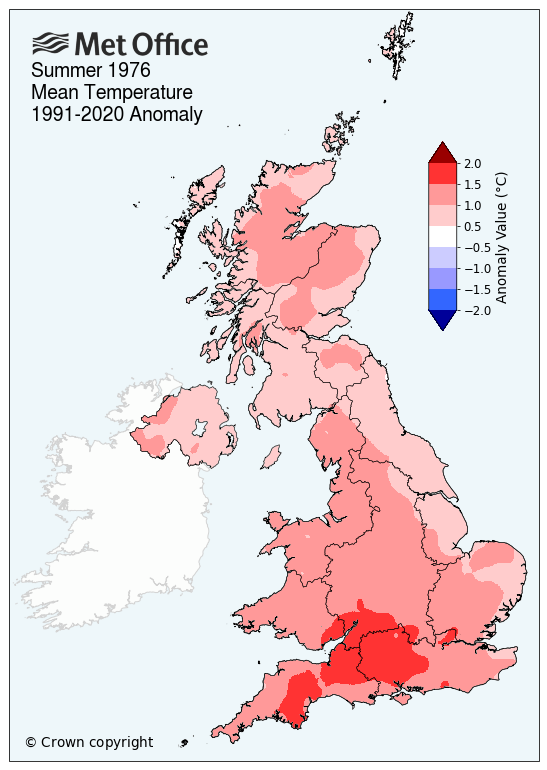Across the UK, mean temperatures averaged across the summer period reached levels never-before recorded, with large swathes of the country experiencing conditions more than 2°C above the seasonal average. Yet, as remarkable as these statistics are, it is crucial to place them in context.
The summer of 1976 is often regarded as the benchmark for extreme British summers. However, the climate in which it occurred was fundamentally different from today’s. While summer 2025 is exceptional in the context of the historical record, just as 1976 was at the time, current climate projections suggest that similar conditions could be much more common in the future.
Maximum and minimum temperatures: a nuanced picture
It is important to distinguish between mean, maximum, and minimum temperatures. While 2025 set new records for mean and minimum temperatures, the record for daily maximum temperature, calculated by averaging the peak temperature of every day through the whole season, across the whole country, still belongs to 1976.
However, although daytime peak temperatures in 2025 were not the highest on record, the sustained warmth, especially at night, made this summer particularly notable.
Dr Mark McCarthy said: “To understand the difference between 2025 and 1976, it is important to look at the factors at play. 1976 was both sunnier and drier overall than 2025, factors that helped contribute to the record high maximum from the heatwaves that occurred that summer. But 2025 had persistent warmth day and night through the summer with few notable cooler spells.

READ MORE: Summer 2025 is the warmest on record for the UK
How hot was summer 2025?
Analysis of the UK’s climate records shows that every region experienced a warmer than average summer in 2025. The most striking feature was the widespread nature of the warmth: the darkest red areas on temperature maps indicated regions where mean temperatures were more than 2°C above the norm, and much of England was at least 1.5°C above average.
Comparing this to the summer of 1976, the differences are clear. In 1976, the areas with mean temperatures above 1.5°C were more isolated, and the overall anomaly was less severe. While 1976 remains striking, the scale and distribution of warmth in 2025 far exceeded that of previous record years.
How does 1976 compare?
The summer of 1976 is legendary in British climate statistics. At the time it was the hottest UK summer on record with the average mean temperature reaching 15.7°C, beating the previous high of 1933 by just over 0.3°C.
The summer we have just experienced saw provisional average mean temperatures exceed 16°C for the first time since records began in 1884: 16.1°C.

The drivers behind the record warmth
Several factors contributed to the exceptional warmth of summer 2025:
- Atmospheric circulation: Persistent high-pressure systems led to extended periods of clear skies and dry weather.
- Soil moisture: Dry conditions from spring meant that soils heated up more quickly, amplifying the summer warmth.
- Marine heatwaves: Sea surface temperatures around the UK were consistently in the heatwave category, with some regions more than a degree above average. This helped maintain high land temperatures, especially at night.
- Climate change: Rising greenhouse gas concentrations have increased the baseline temperature, making record-breaking summers more likely.
READ MORE: Summer 2025: A regional breakdown
How rare is a summer like 2025?
A key question is how truly exceptional was 2025?. Attribution studies show that, in a “natural” climate without human-induced greenhouse gas emissions, a summer like 2025 would be a roughly one-in-340-year event. In our current climate, however, it is estimated to be a one-in-five-year event, approximately 70 times more likely due to human activity. This means that, while summer 2025 is exceptional by historical standards, similar scenarios might be much more common in the near future.
Changing perceptions and adaptation
One reason 2025 may not stand out as much in people’s minds is that the UK has experienced several warm summers in recent decades. The clustering of warm events means that what was once extraordinary is becoming more familiar. However, the changing climate has important implications for how we perceive and adapt to climate change. Buildings in the UK, for example, are often designed to retain heat during the colder winter months, but in a warming climate, keeping them cool during the summer becomes increasingly important.

What is exceptional in our current climate?
While 2025 was a record-breaking summer, it is important to consider what an exceptional scenario might look like in the future. As the climate continues to warm, summers like 2025 will become more common, and even hotter extremes are possible. This underscores the need for ongoing adaptation and resilience planning, from water management to building design.
READ MORE: August 2025 weather stats: A regional breakdown
Mark continued: “The last five decades have seen many changes, including the climate. It is clear that average temperature values across the UK have risen over that time. 1976 was an exceptional year for heat and if a similar event occurred today the background warming due to climate change would mean it would be an even more extreme event.
Summer 2025 was the warmest on record for the UK, with widespread and sustained warmth, notable sunshine, and significant regional dryness. Yet, in the context of a changing climate, its exceptional nature is relative. The summer of 1976 was extraordinary for its time, but in today’s world, summers like 2025 are no longer once-in-a-lifetime events. Understanding this shift is crucial for how we prepare for and respond to future extremes.
Keep up to date with weather warnings, and you can find the latest forecast on our website, on YouTube, by following us on X and Facebook, as well as on our mobile app which is available for iPhone from the App store and for Android from the Google Play store.



